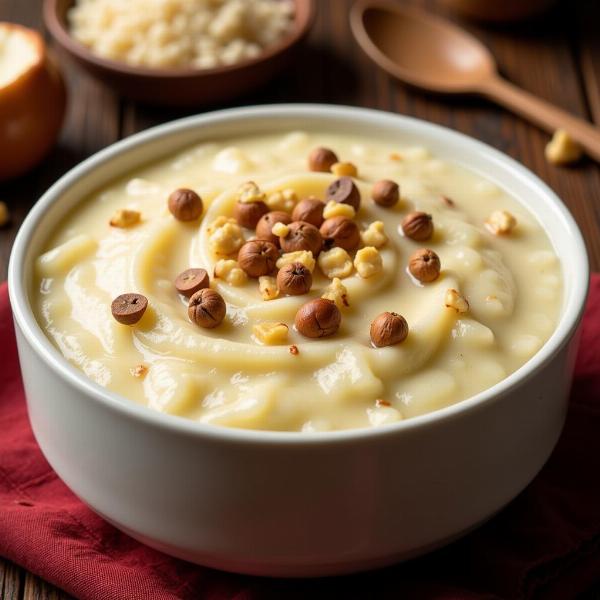Pudding, a beloved dessert in many cultures, often sparks curiosity about its Hindi equivalent. Understanding the hindi meaning of pudding helps bridge cultural gaps and opens up new culinary explorations. This article will delve into the various ways “pudding” is understood and translated in Hindi, exploring cultural nuances and offering practical examples.
Unraveling the Hindi Meaning of Pudding
Translating “pudding” directly into Hindi isn’t straightforward. There isn’t one single perfect equivalent. The meaning depends largely on the type of pudding being referred to. A thick, creamy pudding might be called “kheer” (खीर), a rice pudding popular across India. A firmer, molded pudding might be referred to as “halwa” (हलवा), a dense, sweet confection made from various ingredients like semolina, carrots, or lentils. Sometimes, the more generic term “mithai” (मिठाई), meaning “sweet,” can be used to encompass a broad range of desserts, including pudding-like dishes.
 Hindi Pudding: Kheer
Hindi Pudding: Kheer
Exploring Different Types of “Pudding” in Hindi
The diversity of Indian desserts adds another layer of complexity. Consider “firni” (फिरनी), a creamy rice pudding similar to kheer but often flavored with rosewater or saffron. “Sheera” (शीरा), made from semolina, is another pudding-like dish enjoyed in many Indian households. The term “custard” (कस्टर्ड), borrowed from English, is also commonly used for egg-based puddings.
What do Indians Call Pudding?
Indians often use descriptive terms based on the ingredients and consistency of the pudding. For instance, a bread pudding might be called “bread ka halwa” (ब्रेड का हलवा). This descriptive approach reflects the emphasis on ingredients and preparation methods in Indian cuisine. Understanding this nuance helps in accurately conveying the meaning of “pudding” in a Hindi context.
Pudding in Indian Culinary Culture
Pudding, in its various forms, plays a significant role in Indian cuisine. From festive occasions to everyday meals, these sweet treats are a symbol of celebration and hospitality. Kheer is often served during religious ceremonies and festivals. Halwa is a popular dessert offered to guests. The variety of puddings showcases the rich culinary heritage of India.
Conclusion
The hindi meaning of pudding isn’t confined to a single word. It’s a nuanced concept encompassing a delightful array of sweet dishes. From kheer to halwa, firni to sheera, Indian cuisine offers a rich tapestry of pudding-like desserts. By understanding the cultural context and regional variations, we can appreciate the true meaning and significance of “pudding” in Hindi.
FAQ
- What is the closest Hindi word to pudding? Depending on the type, “kheer” or “halwa” are often the closest equivalents.
- Is mithai the same as pudding? Mithai is a broader term for sweets, encompassing various desserts including some that resemble pudding.
- What are some popular Indian puddings? Kheer, halwa, firni, and sheera are among the most popular.
- Are Indian puddings always made with rice? No, they can be made with various ingredients like semolina, lentils, carrots, and even bread.
- When are Indian puddings typically eaten? They are enjoyed on festive occasions, as part of everyday meals, and as offerings to guests.
- Are there regional variations in Indian puddings? Yes, different regions have their own unique versions and flavors of puddings.
- Where can I find recipes for Indian puddings? Numerous online resources and cookbooks offer authentic recipes for various Indian puddings.
Meaning-Hindi.in is your trusted partner for accurate and culturally sensitive Hindi translations. We offer a wide range of translation services, including business and commercial document translation, certified and legal document translation, technical and user manual translation, website and localization services, educational and academic document translation, express translation, and specialized translation services. Contact us today at [email protected] or +91 11-4502-7584 to discuss your translation needs. Meaning-Hindi.in is dedicated to bridging language barriers and fostering clear communication across cultures.